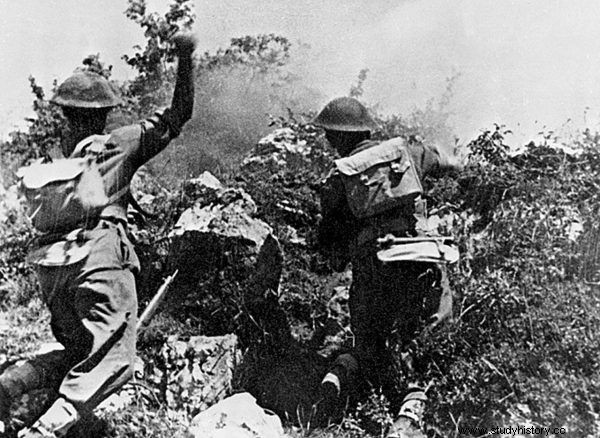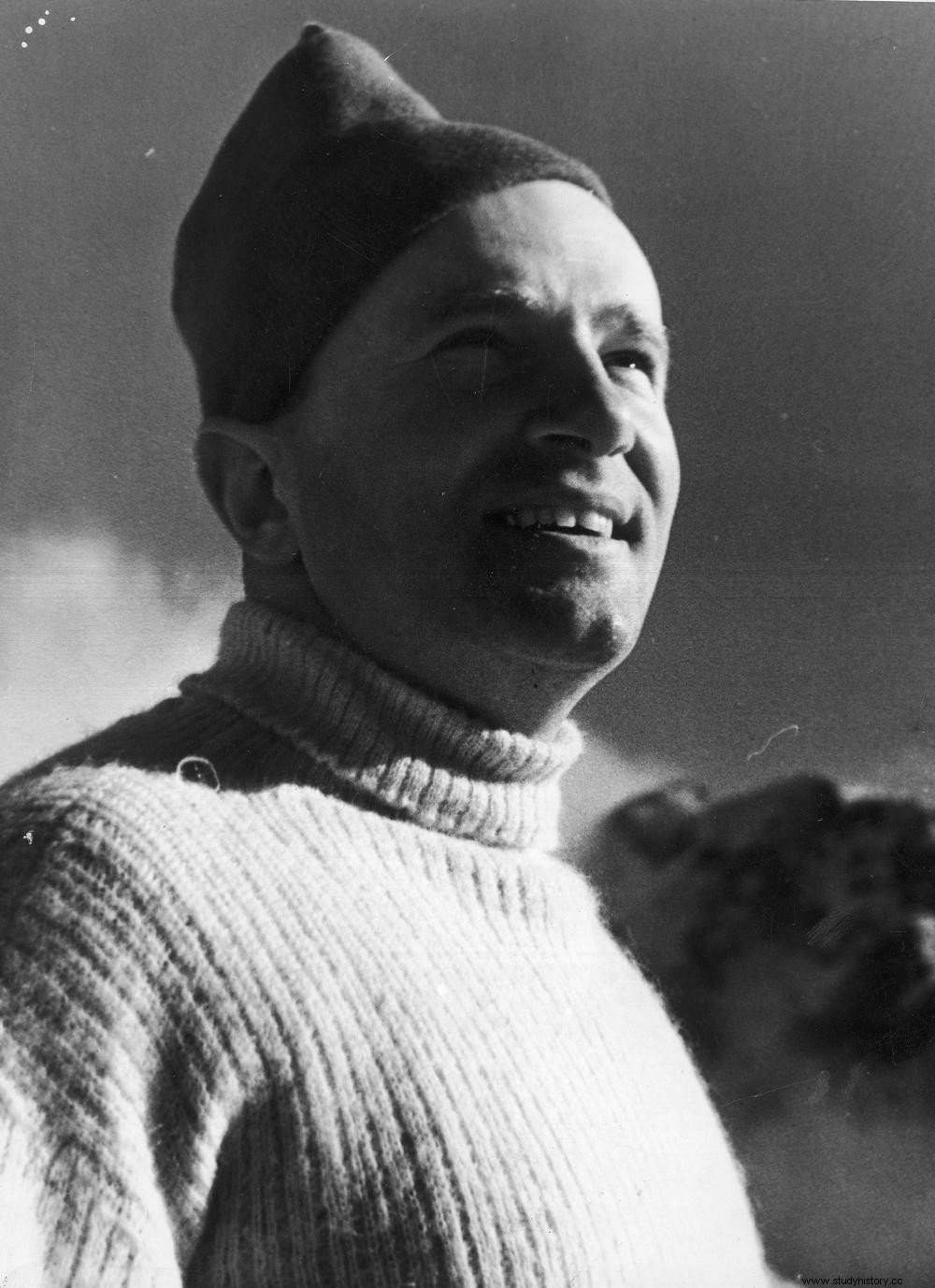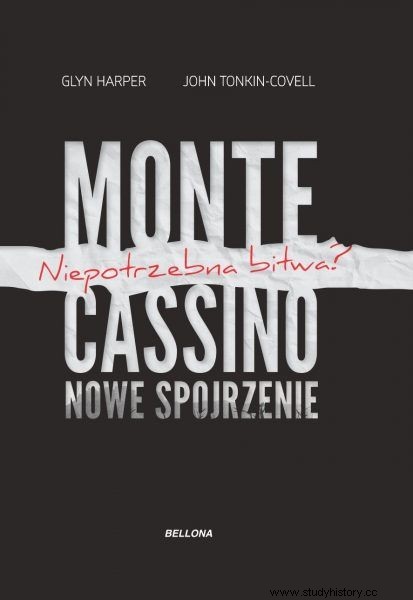We remember our countrymen, whose heroic assault led to the breaking of the fortified Gustav Line. But what about those Poles who fought alongside the Germans in defense of Monte Cassino? There were many more than you might suspect.
About 1,070 soldiers of the 2nd Polish Corps, who died in the attacks on the monastery in May 1944, were buried at the cemetery in Monte Cassino. However, during this battle, Poles died more often, although some of them did not attack, but defended the monastery. Several hundred of their graves are located in the nearby German cemetery.
About 400 Silesians alone were buried at Monte Cassino - half of them lie in the Polish cemetery, and half - in the German one. It all depended on the uniform in which their death had hit them. There is even a case of natural brothers lying in different cemeteries:one died storming the monastery, the other defending it.
War luck or lack thereof
Some were lucky, like Jan Gazur from Cieszyn Silesia. At Monte Cassino, he was a member of the German machine gun team in one of the fortifications. A Silesian in a German uniform knew that his bunker was being attacked by Poles and was waiting for an opportunity to change sides of the conflict. Although the fortification was damaged, fortunately he was not hit by Polish missiles. "Don't cut your hair, I'm eating a Pole!" he cried out to his countrymen. They did not shoot, they took it with them, and the happy Silesian, wearing the German uniform all the time, also took part in the counter-attack on his recent comrades. Only then did it hit the rear.

The soldiers of the 2nd Corps storm the hill "593". Who knows if they have compatriots forcibly conscripted into the Wehrmacht opposite each other?
Another Silesian was unlucky. “The young German has thrown back the hemp hair and is lying - stiff forever. When, after the second attack, the workers of the Italian company put up with his decaying body, two letters were found in his wallet ", wrote war correspondent Melchior Wańkowicz about him in his book about the battle, where he immortalized him in the subtitle:" He will not see "Siegmondek" blooming anymore>> steep <<”.
The fights for the monastery were fierce, and the losses were large. Artillery and mortar shells fell on the defenders and attackers, mines exploded, tanks and snipers fired, soldiers on both sides fired machine guns, threw grenades, and used flamethrowers. In many of the battle stations, ruthless short-range fights were fought. Sergeant Antoni Kmietowicz, whose unit attacked the position of "Widmo", recalled:
I put the thomigan series in a half-sheet window. Then we throw grenades on the opposite wall and quickly run to the windows, shooting. When I got to the window, I saw a shelter against the wall, right under my feet, on which a killed German was lying face down, and murmurs in the shelter. One and the other bursts into the bunker opening, followed by two grenades. In a few seconds, smoke, dust and the suffocating gurgling of the dying Germans emerge from the shelter " .
In this section, the fights were fought almost hand-to-hand, firing machine guns at a distance of 10 meters. Under such circumstances, there was no time to ask if there are countrymen among the defenders and call them to surrender. And there could have been a lot of Poles there, they were even in Slovak uniforms, summoned to the army of priest Jozef Tiso in the occupied territories of Spisz.
The soldiers from the 1st Independent Commando Company, who had a fight for the monastery in January 1944, clashed with German mountain shooters were probably the most convinced ones. One of them was killed with a dagger by the senior shooter Zenon Kaszubski. When the property of the deceased was searched, it turned out that he had letters written in Polish in his pocket and a stamp with the word "Posen" on the postage stamp. Years later, this is how Kacper Śledziński assessed the situation:
Fate wanted two people from Poznań - because Kashubian came from this city as well - to fight a deadly competition in a village lost between the hills of Italy .

Maciej Zajączkowski described in his memoirs a moving moment of discovering that our commandos fought a fratricidal fight with Poles in German uniforms.
Unfortunately, this was not the only such case. A Polish commando officer, Lieutenant Maciej Zajączkowski, while browsing through the belongings of fallen opponents, whom his subordinates had eliminated, noted hotly:
The headlines catch the eye of well-known names:Katowice ..., Pszczyna ..., Wisła ..., Gorlice ..., and then how expensive, and how long unheard words:"Dear little brother ... "," Dear son ... ". (...) somewhere far away in the country, maybe even in the same city, for me and for my opponent, a pleading plea is made in the same language:"(...) for the happy return of our sons to the doorsteps we ask You, Lord .
What was it with my grandfather from the Wehrmacht
As many as 500,000 Poles could serve in Adolf Hitler's army - more than in the Polish Armed Forces in the West and in the Polish army in the USSR. Most of them were incorporated from Silesia (approx. 350-400 thousand, including compatriots who lived in its Polish and German parts before the war) and from Pomerania (over 80 thousand).

German war cemetery in Pomezia. The remains of Polish soldiers who fought in the Battle of Monte Cassino are also buried here.
Most of the conscription resulted from the choice of the lesser evil. In 1939, in some of the areas incorporated into the Third Reich, i.e. in the former territories of the German Empire, a police census was carried out, in which the inhabitants were to identify themselves as Poles or Germans. The already known persecution - including the execution of former Silesian insurgents - prompted the choice of the German option. No wonder that Polish authorities in exile and priests persuaded them to settle in the occupied territories in such a way.
It was among those families declaring themselves to be Germans that the conscription began. It became massive when the German National List (Deutsche Volksliste) was announced in March 1941, dividing those who called themselves Germans into four categories, the third and fourth of which exempted from conscription but did not protect them from repression, such as deportation to General Government.
After the defeat at Stalingrad, when the army began to demand supplements, the criteria were lowered, taking into the army those with the third category, arms industry workers, concentration camp prisoners held there for pro-Polish activities, and even suspected of cooperation with the Polish Underground.

After the defeat at Stalingrad, the Germans needed replenishment. As a result, there were hundreds of thousands of Poles in the ranks of the Wehrmacht.
Poles in German uniforms died on all fronts. “There are six more nose left of the train that left Hanover. The rest - all killed. (...) Mother, say goodbye to you, because I am not coming back from this war. Wos will never see anything, nor my Bojszów ”, wrote Wojciech Czarnynoga in his last letter to his mother, who died on the German side at Monte Cassino.

Poles who were forcibly conscripted into the German army were often chased out of prisoners of war and drafted into the Polish army.
Poles in the German army were rather not persecuted, although they were viewed with distrust, and attempts to defect, break discipline or sabotage were punished with death. They were also hostages:in the event of desertion, their families could end up in concentration camps.
They were not accepted into armored forces, submarines, aviation or reconnaissance, they were not created into separate units of Pomeranian or Upper Silesian regiments, they were distributed individually or several to platoons. The pinnacle of promotion for most of them was the rank of senior shooter. Many of the conscripts did not know German well enough and waited for the possibility of a livery change.
German renegades, or Polish reserves
Former vermacht owners were skillfully drafted into the Polish army. First of all, they had to be pulled out of the crowd of other prisoners so that they did not find out that they wanted to change their uniforms, because they could fall victim to lynching at the hands of German comrades. It was helpful to check the Red Cross questionnaires that were filled in by prisoners, transfer them to other camps, or efficiently changing into a Polish uniform in one of the barracks and taking them out through another exit.
The further the Polish army went north in Italy, the more recovered soldiers joined its ranks. Aleksander Topolski, a soldier of the 2nd Corps recalled:
Could we count on the loyalty of the soldiers who fought in the German ranks for several years, first in Russia and then in Italy? However, all fears were in vain. They turned out to be exceptionally patriotic Poles, (...) absolutely loyal. They were highly trained, careful, and yet brave when needed. The influx of recruits allowed the expansion of the two divisions with the third brigade. Thus, the position recommended by the British instructions was reached. Moreover, the organization of the armored division was seriously considered; artillery strength was increased. The corps was stronger than ever before the Battle of Bologna .

It is estimated that about 70-90 thousand Poles conscripted into the Wehrmacht entered the Polish army in the West from prisoner-of-war camps or directly from the battlefields. Most of them served under false names so that if they were captured, the Germans would not cover their families with repressions. However, the new soldiers also distinguished themselves in the Polish ranks with their different behavior. Lieutenant Adam Majewski from the 3rd Carpathian Rifle Division recalled:
What the hell ours, not ours. ...
And he added:
I hope our people will quickly wean them from these Swabian manners (...) I dealt with one case in the [brigade's] office, and here comes a "kesselringowiec" with a patter, he puts his hand up and screams, "Heil!" He did not have time to add "Hitler", because all faith in the office does not roar with laughter. He stood as tight as a string and he didn't know what to say, tears in his eyes. He was no more than nineteen. In the end, we felt sorry for him. The captain came up to him, patted him on the back and said:Don't worry man, it will come off you like bad skin from a snake.
Sometimes, however, the Prussian drill instilled in them could make them not laugh, but real trouble. One of the ex-Wehrmachtmen who was on duty at the police station at night could speak of great luck, and when the phone rang, he instinctively reported in German. His supervisor calling him did not recognize him by his voice and shouting, "Fuck, there are holes in the office!" organized an assault group. Fortunately, the situation cleared up before the firing and throwing grenades started.

Poles fought against each other not only at Monte Cassino. The photo shows a Pole incorporated into the Wehrmacht talking to the soldiers of the 1st Armored Division of general Stanisław Maczek in Normandy.
The soldiers recovered from the Germans could not be denied. And a sense of humor, because they joked with each other, asking how correctly, according to the hierarchy of awards, to hang the Cross of Valor on their chests - in front of the Iron Cross or behind it.
It is worth adding that not only Poles were forcibly conscripted into the German army. The French from the former imperial provinces - Alsace and Lorraine, as well as Latvians and Estonians were incorporated into the Wehrmacht into the Waffen-SS as pseudo-volunteers. Meanwhile, there was a risk of staying in a concentration camp for refusing to appear before the commission. Forced conscription in the occupied territories was also carried out by the Red Army among Poles, Lithuanians, Latvians and Estonians. In many countries, however, there were also those who wanted to join the German troops themselves - those most often ended up in the Waffen-SS or in various auxiliary units.
